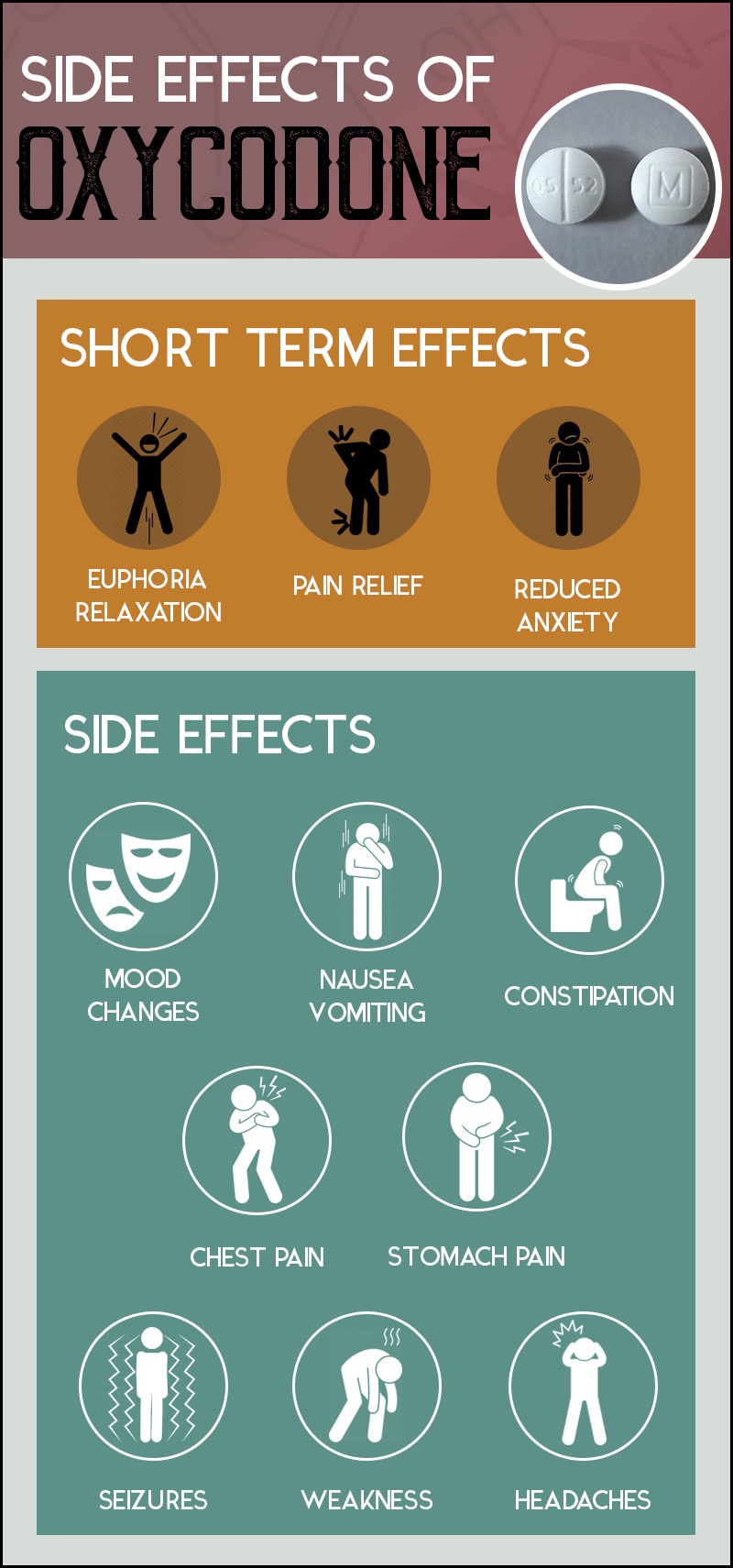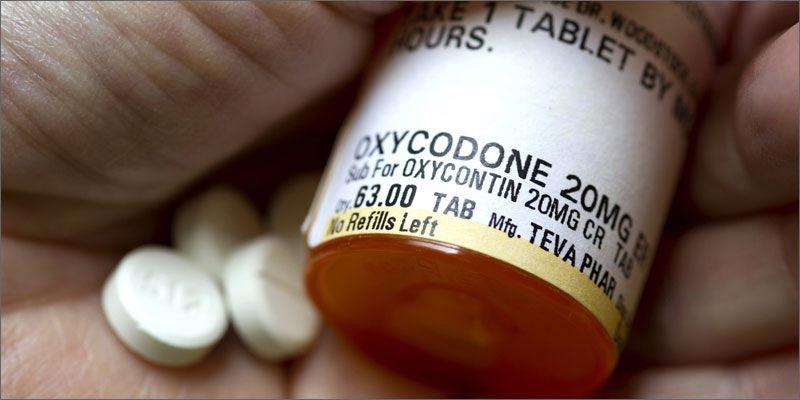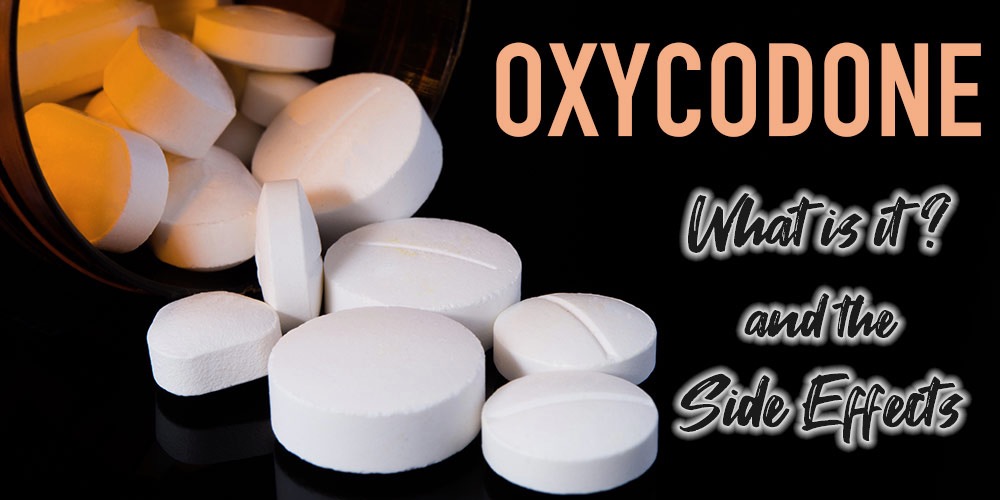What is Oxycodone?
Oxycodone is an opioid drug, commonly known under the brand names Oxycontin and Percocet. It is primarily prescribed to relieve moderate to severe pain, although it’s important to be aware of Oxycodone side effects for anyone that is taking it.
In addition to treating pain, it is sometimes prescribed as a cough suppressant, although the FDA recently banned cold and cough medicines for children that contain oxycodone.
It is also used recreationally, and is considered central to the opioid addiction crisis in the United States and Canada. It is an example of a semisynthetic opioid, rather than an entirely synthetic opioid, such as fentanyl.
While usually taken orally, oxycodone can also be administered via intravenous or intramuscular methods. In pill form, it is available in both immediate and controlled-release variations.
Oxycodone Side Effects
Oxycodone side effects will be reduced when it is used as prescribed by a doctor and not taken recreationally.

The intended, short-term Oxycodone side effects are:
- Pain relief
- Relaxation
- Reduced anxiety
Negative Oxycodone side effects may also include some of the following:
- Mood changes
- Nausea and vomiting
- Constipation
- Chest pain
- Stomach pain
- Seizures
- Weakness
- Headaches
It is important to note that, even when taken as prescribed, there is a significant risk of becoming physically or psychologically dependent on the drug. Oxycodone has also been known to impede respiratory function.
Drinking alcohol while taking oxycodone can be especially dangerous, given that the two drugs produce similar effects. Taking these drugs in combination heightens the risk of lethal overdose.
In the short-term, oxycodone has the potential to be an effective pain reliever for those dealing with chronic pain. However, it can also have severe detrimental effects.
Long-term use has been linked to irreversible kidney and liver damage and failure. The risk of severe liver damage is especially present with combination drugs, such as medications that combine oxycodone and acetaminophen.

Oxycodone Side Effects of Misuse
Oxycodone is classified by the Controlled Substances Act as a Schedule II drug, meaning that it:
- Has a high potential for abuse
- Is currently accepted for medical use, and
- May lead to severe psychological or physiological dependence
The high potential for abuse is due to oxycodone’s ability to induce euphoria in the user. Those seeking the experiential effects will take it for this reason, rather than strictly for a medical reason.
It is possible to misuse oxycodone that has been prescribed by a doctor, as well as oxycodone that has been illicitly procured. In addition to taking the drug for the experiential effects, “misuse” also describes:
- Taking the drug in a way that deviates from doctor’s instruction
- Taking someone else’s oxycodone prescription
All opioids have the potential to be misused and the opioid epidemic has lead to many overdose deaths in the past decade. Fortunately, Narcan nasal spray has shown to be effective for decreasing the number of deaths in recent years.
Taken as prescribed per a doctor’s instruction is the safest way to use the drug and reduces many of the Oxycodone side effects, although the potential risk for psychological or physiological addiction remains present.
Despite the high potential for abuse and dependence, oxycodone continues to be used for pain management due to its availability and efficacy.
Oxycodone Dependence and Addiction
Given that oxycodone is classified as a Schedule II drug, it is considered to have highly addictive properties. It is possible to become psychologically addicted, physiologically addicted, or both.
Psychological addiction often results in response to the relaxation and euphoria that can be induced by opioids such as Oxycontin and Percocet. Those psychologically addicted will compulsively seek this pleasurable feeling.
Physiological addiction results from the body adapting to the consistent or regular presence of opioids like oxycodone, and the user begins to rely on its presence. Once physiologically dependent, the body will exhibit withdrawal symptoms if regular doses are brought to a halt.
Oxycodone dependence is typically apparent when someone compulsively uses it despite evident harm. They experience a craving for the drug, and tend to fixate on the idea of the drug.
Other areas of their lives see diminished participation or effort, as these areas fall second to the use of the drug.
Physical dependence is typically apparent when the user develops a tolerance to the drug, having to use higher doses of the drug to achieve similar effects.
Treatment for Oxycodone Addiction
Oxycodone addiction treatment usually begins with supervised detox to provide a safe and comfortable environment during the withdrawal phase.
Withdrawal from any long-term opioid misuse can be painful, intimidating, and cause intense flu-like symptoms. Many people addicted to opioids fear detox more than treatment.
Opioid detox usually lasts for approximately 7 days, and when completed, the next step is a residential, in-patient treatment program for at least 30 days, although it’s not uncommon for a stay to be for 60 to 90 days.
At Oro House, we understand how difficult recovery from oxcodone addiction can be, which is why we offer a comprehensive program that includes supervised detox followed by our non 12 step treatment program.
Our caring and professional therapists are leaders in the Compassionate Care Model of recovery that is the cornerstone of our treatment centers.
We offer a wide range of proven treatment therapies to empower our clients to change their own lives for the better.
Even though addiction is one of the most extreme Oxycodone side effects a user may encounter, it is possible to recover with proper treatment.
Related Posts
- Long Term Side Effects of Drugs and Addiction
There's a lengthy list of long-term side effects of drugs and addiction that affect both…
- Gabapentin High, Side Effects and Dangerous Misuse
There’s no hiding from it, the opioid crisis is making headlines the world over. At…
- Triple C Side Effects and Abuse
Contrary to common misconceptions, over-the-counter drugs like Triple C are not automatically safe just because…

